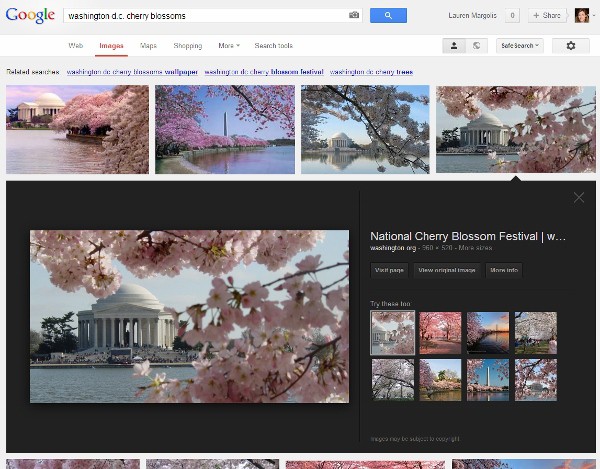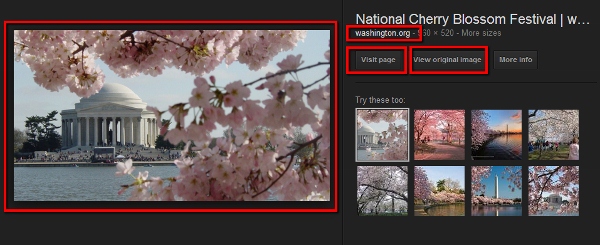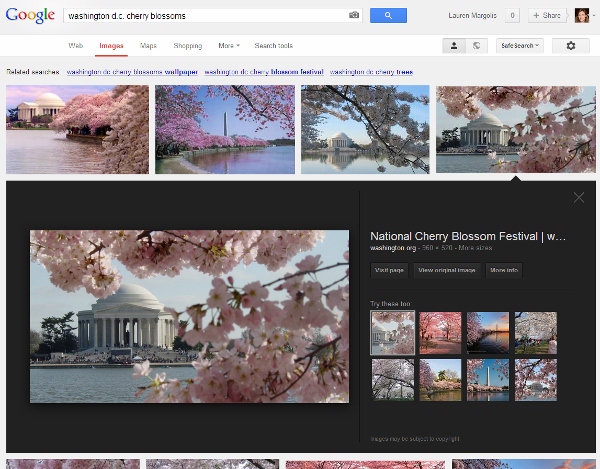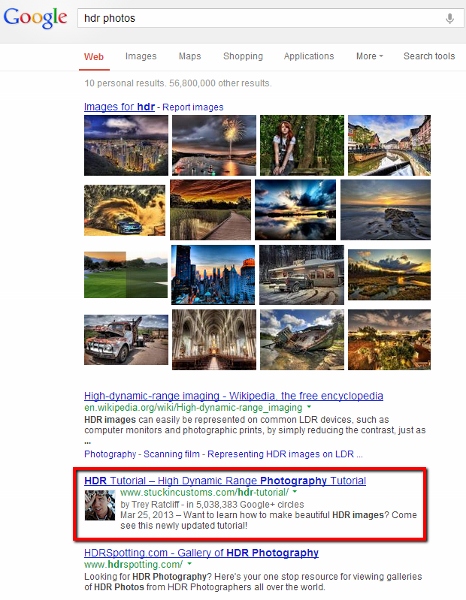Share
How the New Google Images is Changing Traffic to Your Site
By now you’ve probably noticed Google’s new and “faster” image search, launched in late January 2013, which displays larger images in an in...

By now you’ve probably noticed Google’s new and “faster” image search, launched in late January 2013, which displays larger images in an inline panel that lets users flip through image search results. But many in the webmaster and search engine marketing community are not happy about the impact these updates are having on referral traffic coming from Google Images.
So what’s been the result and how has it affected your website? The change means that the source page (i.e. your website) will no longer load up in an iframe in the background.
Users can click the displayed domain name, “Visit page”, “View original image” or the image itself to navigate to the source page. While the new search seems highly intuitive for someone searching Google Images, analytics suggest that fewer users are clicking to the source page.

Users can click any of the four links boxed in red above to navigate to the image’s original source page.
In the past three months, we’ve seen a 78.69% drop in traffic to PhotoShelter members’ websites from Google Images search results (not Google web search results, but specifically image search results).
Why did Google do this?
One idea about the “why” of this change is that it’s a content grab on Google’s part. Other updates, like including IMDb results on the sidebar when you search a movie or Wikipedia results when searching a notable person, are other recent tactics that Google has employed to keep you in their ecosystem instead of visiting the “destination” site.
In many ways it provides a better user experience, but it also removes the need to utilize other sites. Some SEO consultants also suggest there’s danger here, because users no longer find the need to navigate to the source page now that they can see (and potentially steal) a high res photo directly on Google.
Is anyone else seeing these results?
PhotoShelter members are far from alone on this point – it’s an issue that the entire SEO community is grappling with. Webmasters were quick to react on dedicated forms like WebmasterWorld and Digital Point. An SEO consultant shared the effects one of his clients saw within a month of the change. The client is an artist and her site is 99% images – the consultant observed an 80+% drop in referral traffic from Google Images.
More recently, SEO consulting firm Define Media Group analyzed 87 domains worldwide from a variety of networks and business verticals, and found an average 63% decrease in referral traffic from Google Images after the January update. Those defined as “photo sites” are down 74%. Fashion, lifestyle, and entertainment sites are down 78%.
What happened?
PhotoShelter members have always seen a steady stream of referral traffic from Google Images (as is the case for most photographers’ websites). In 2012, the average number of visits to PhotoShelter members’ sites (in aggregate) from Google Images actually increased by 35.19% in the second half of the year.

Referral traffic to PhotoShelter members’ sites from Google Images increased by 35.19% in the second half of 2012.
Then on January 27, 2013 – the first full week after Google’s update to its image search – something changed:

In the three months since the January 23rd update to Google Images, referral traffic from Google Images has decreased by 78.69%.
Here’s a closer look at that data from the past 6 months:
A nearly 80% drop in referral traffic from one of the top three referring sites to PhotoShelter members’ sites is nothing to scoff at. But there are some important things to note:
- Referral traffic from Google web search has remained relatively consistent over the last year and a half.
- Average site visit duration (how long someone spends on your website during one visit) and number of pages per visit have also stayed nearly the same.
- Bounce rate and percent of new visitors (people who have never been to your site before) have also stayed about the same.
The community is also talking about the concept of a “truer visit”. Internet marketers at MoreVisilibity explain that with the new image search, Google Analytics code does not have a chance to fire, “removing page view credit and decreasing referral traffic.” Meaning that it’s possible many of the visits you were seeing before were people who saw your image in the iframe that popped open in the background, but these people never actually clicked through to your website at all. So while this change may seem extreme, it might just be a more accurate count of visitors who click through to the original source.
So while the absolute number of visitors to your site may have decreased in the last three months, the true visitors are still behaving the same once they land on your website – which makes sense assuming you haven’t made any major changes in that time.
What can you do about it?
First, you need to truly assess the impact beyond simply reading the analytics. Start by asking if your business has been materially impacted in any way. If not, then the concept of a “truer visit” may actually be relevant to you.
Still, if Google Images is only sending a fraction of the “useful” traffic to your site as it previously did, then you might consider focusing on other traffic sources. For example, the #1 source of referral traffic to PhotoShelter members’ sites in 2012 was Facebook. Google Images and PhotoShelter.com were #2 and #3, followed by Twitter and Pinterest.
It’s also clear at this point that Google is taking social media – specifically Google+ – activity into account when ranking search results.
The photographer community has continued to grow on Google+, but if you’re still averse to getting active on another social media platform, consider this: Google Authorship, which links the content you post on a specific domain (i.e. your photography website) with your Google+ profile, is becoming a huge factor in how Google ranks your website. People who have set this up are often ranked higher for their targeted keywords. (Read more and learn how to set up Google Authorship here.)
Trey Ratcliff, known for his huge presence on Google+, ranks on the first page of search results for the term “hdr photos”. His headshot and name show up in the search results because of his Google Authorship (of course, over 5 million people have Trey in their circles, so keep that in perspective).
Overall, best practices in the wake of Google Image search update will likely be to continue optimizing your website with on-page text that Google can crawl and index in regular search, and build authorship via Google+ to help influence how your content appears in search results. Likewise, we will continue to optimize our own tools to help facilitate this.
How can you see the changes to your website’s traffic?
To see how your traffic has changed, log into your Google Analytics account and navigate to Traffic Sources>Sources>Referrals. Click on the google.com link and look for /imgres. Clicking this will give you a picture of how referral traffic from Google Images has changed over time. Be sure to look at a time period containing the week of January 28th, 2013 (the first full week after the update).






